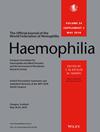Identification and Analysis of Mitochondria-Related Proteins in Haemophilic Arthritis Synovial Membranes Based on Proteomic Analysis
Abstract
Background
Haemophilic arthritis (HA), a severe complication in haemophiliacs, is driven by recurrent joint bleeding and iron overload from haemosiderin deposition, leading to synovial damage and joint dysfunction. Previous studies have examined the effects of iron overload on mitochondrial function, but the mechanisms linking iron metabolism disorders to mitochondrial dysfunction in HA remain poorly understood.
Methods
Comparative analyses of synovial samples from patients with advanced HA and osteoarthritis (OA) were performed using a proteomic approach. Differentially Expressed Proteins (DEPs) linked to mitochondrial function were identified and analysed for gene ontology (GO) and KEGG enrichment. A protein-protein interaction (PPI) network was constructed and findings were validated using Western blotting and Immunohistochemistry (IHC).
Results
A total of 152 mitochondria-associated DEPs were identified, significantly enriched in processes such as oxidative phosphorylation, aerobic respiration and the TCA cycle. KEGG analysis revealed disruption of pathways including oxidative phosphorylation and fatty acid metabolism, highlighting metabolic dysregulation in advanced HA synovium. TEM analysis revealed mitochondrial abnormalities including swelling, cristae breaks and iron deposition. NDUFS1 and SOD2 were significantly down-regulated in advanced HA synovium, linked to reduce mitochondrial efficiency and enhanced oxidative stress.
Conclusion
This study identifies molecular pathways and proteins linked to mitochondrial dysfunction in advanced HA, including those involved in the TCA cycle, oxidative phosphorylation and oxidative stress responses. The reduction in NDUFS1 and SOD2 expression may be correlated with mitochondrial dysfunction caused by iron overload in synovial fibroblasts. They provide new insights into the pathogenesis of late-stage HA and offer potential avenues for mitochondria-targeted therapeutic strategies.


 求助内容:
求助内容: 应助结果提醒方式:
应助结果提醒方式:


